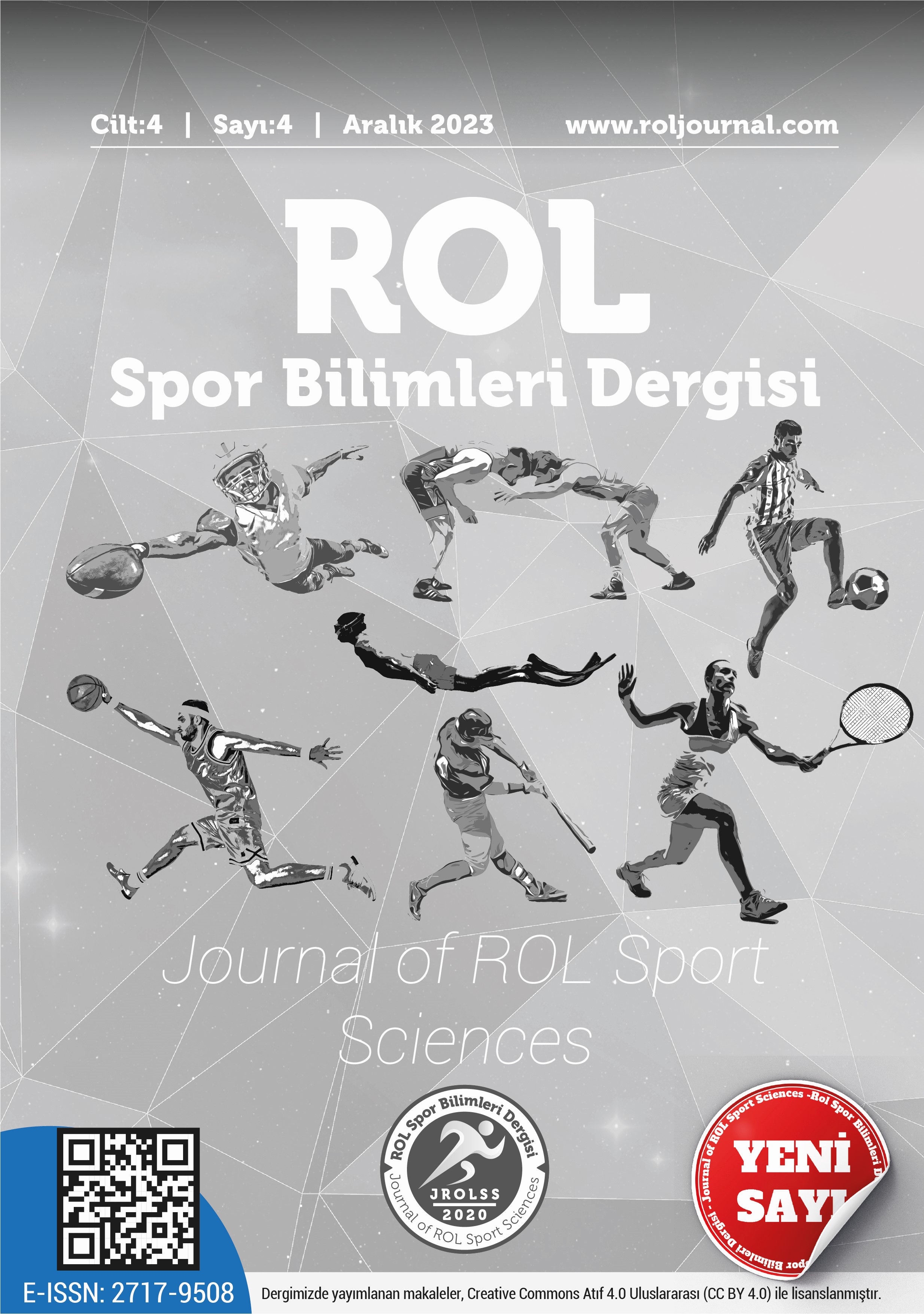Investigation of the relationship between personality traits and sports consumption of volunteers working in international sports organizations
DOI:
https://doi.org/10.5281/zenodo.10404493Keywords:
personality, sport consumption, voluteeringAbstract
The purpose of this research; The aim of this study is to examine the relationship between the personality traits of the volunteers participating in the 5th Islamic Solidarity Games held in Konya in 2022 and their consumption of sports in terms of demographic variables. Relational screening model was used in accordance with the purpose of the research. While the population of the research consists of 1500 people who voluntarily participated in the 5th Islamic Solidarity Games held in Konya, the sample consists of 334 volunteer participants determined by simple random method. “Personal Information Form”, “Ten-Item Personality Scale (TSPS)” and “Sports Consumption Scale (SBL)” were used as data collection tools. The obtained data were analyzed by transferring them to the SPSS 25.0 package program. Frequency, percentage, mean and standard deviation analyzes were used in descriptive data analysis. In the analysis of the data, t-test for pairwise comparisons and One-Way Anova Test for multiple comparisons were applied to examine the differences between variables. Pearson Correlation Test was applied to examine the relationships between the variables. In addition, Tukey and LSD from multiple comparison tests were used. According to the research findings, the participants; It has been found that there are differences according to variables such as gender, age, volunteering experience, educational status, marital status, economic income, participation in sports as an active and spectator. In conclusion; In line with the data taken from the sample and the correlation analysis, a low positive correlation was found between the "responsibility" sub-dimension and the "sports product consumption" sub-dimension in the relationship of the sub-dimensions with each other.
References
Acar, R. (2017). Mardin il bölgesinde okullardaki sosyal etkinliklerin (tiyatro, müzik, spor, dans, şenlikler) lise dönemi ergen (14-18 yaş) kişiliğe etkileri [Yüksek lisans tezi, İstanbul Gelişim Üniversitesi].
Atak, H. (2013). On-Maddeli kişilik ölçeği’nin Türk kültürü’ne uyarlanması. Archives of Neuropsychiatry/Noropsikiatri Arsivi, 50(4).
Baudrillard, J. (2015). Tüketim toplumu: Söylenceleri/yapıları. Ayrıntı Yayınları.
Bulut, B. A. (2021). Uluslararası spor organizasyonlarında görev alan gönüllülerin kişilik özelliklerinin sporda gönüllülük motivasyonları üzerine etkisinin incelenmesi (İstanbul Örneği) [Yüksek lisans tezi, İstanbul Gelişim Üniversitesi].
Chen, L. C. (2008). Research on emotional intelligence measurements and adaptive index of junior high school students. Bulletin of Educational Psychology, 39, 61-81.
Elmas, M. (2018). Üniversite öğrencilerinin spor tüketimlerinin araştırılması [Yüksek lisans tezi, Ankara Üniversitesi].
Erdeveciler, Ö., Elmas, M., & Balcı, V. (2018) Spor Tüketim Ölçeği geliştirme çalışması [Uluslararası Rekreasyon ve Spor Yönetimi Kongresi], Muğla, Türkiye.
Goldberg, L. R. (1992). The development of markers for the Big-Five factor structure. Psychological assessment, 4(1), 26.
Gosling, S. D., Rentfrow, P. J., & Swann J. W. B. (2003). A very brief measure of the Big-Five personality domains. Journal of Research in personality, 37(6), 504-528.
Komarova, E. P., Fetisov, A. S., Larina, T. V., & Galustyan, O. V. (2017). The development of physical training culture of a personality. Revista Espacios, 38(50).
McCrae, R. R., & Costa, P. T. (2003). Personality in adulthood: A five-factor theory perspective. Guilford Press.
Mullin, B. J., Hardy, S., & Sutton, W. (2014). Sport marketing 4th edition. Human Kinetics.
Odabaşı, Y. (1999). Tüketim kültürü: Yetinen toplumun tüketen topluma dönüşümü. Sistem Yayıncılık.
Öztürk, M. (2013). Kapitalizmin arzu üzerinden üretimi ya da arzunun nesneleş(tiril)mesi. Elektronik Sosyal Bilimler Dergisi, 12(44), 151-180.
Shrivastava, P., VenuGopal, R., & Singh, Y. (2010). A study of personality dimensions in sports performance. Journal of Exercise Science and Physiotherapy, 6(1), 39-42.
Smith, M. A., & Canger, J. M. (2004). Effects of supervisor “big five” personality on subordinate attitudes. Journal of business and psychology, 18(4), 465-481.
Soto, C. J., & Jackson, J. J. (2013). Five-factor model of personality. Journal of Research in Personality, 42, 1285-1302.
Szwacka-Mokrzycka, J. (2015). Trends in consumer behaviour changes. overview of concepts. Acta Scientiarum Polonorum. Oeconomia, 14(3).
Tabachnick, B. G., & Fidell, L. S. (2007). Using Multivariate Statistics, Allyn dan Bacon.
Tanrıverdi, H., Yılmaz, A., Pala, B., & Ercan, F. Z. (2019). Kişilik özellikleri, duygusal zekâ, kariyer uyum yeteneği ve turizmde kariyer yapma isteği arasındaki ilişkilerin incelenmesi: İstanbul Üniversitesinde turizm işletmeciliği eğitimi alan öğrenciler üzerine bir araştırma. Uluslararası Turizm, Ekonomi ve İşletme Bilimleri Dergisi, 3(1), 41-56.
Tolukan, E., & Yılmaz, B. (2016). Özel yetenekle ilgili bölümlerde okuyan öğrencilerin rekreasyonel aktivitelere katılımlarına engel olabilecek unsurların belirlenmesi. International Journal of Sport Culture and Science, 2(Special Issue 1), 525-539.
Yıldız, A. B., Bülbül, D., & Doğu, G. A. (2021). Ragbi sporcularında duygusal zekâ ve kişilik özellikleri arasındaki ilişkinin incelenmesi. Akdeniz Spor Bilimleri Dergisi, 4(3), 380-390.
Yurtsızoğlu, Z., & Gül, O. (2022). Spor takımı taraftarının etnosentrik tüketim eğilimi. Yönetim Bilimleri Dergisi, 20(45), 589-612. https://doi.org/10.35408/comuybd.1017290
Zorlu, E., Doğu, G. A., Yıldız, A. B., & Yılmaz, B. (2020). Atletizm branşındaki sporcuların kişilik özelliklerinin başarı motivasyonuna etkisinin incelenmesi. Akdeniz Spor Bilimleri Dergisi, 3(1), 24-35.
Downloads
Published
How to Cite
Issue
Section
License
Copyright (c) 2023 Journal of ROL Sport Sciences

This work is licensed under a Creative Commons Attribution 4.0 International License.

